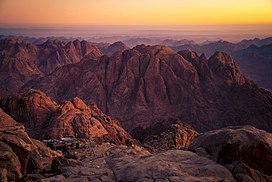Mount Sinai (Hebrew: הַר סִינָֽי Har Sīnay; Aramaic: ܛܘܪܐ ܕܣܝܢܝ Ṭūrāʾ dəSīnăy; Coptic: Ⲡⲧⲟⲟⲩ Ⲥⲓⲛⲁ), also known as Jabal Musa (Arabic: جَبَل مُوسَىٰ, translation: Mountain of Moses), is a mountain on the Sinai PeninsulaofEgypt. It is one of several locations claimed to be the biblical Mount Sinai, the place where, according to the Torah, Bible, and Quran, Moses received the Ten Commandments.
| Mount Sinai | |
|---|---|
| Egyptian Arabic: جَبَل مُوسَىٰ, romanized: Gabal Mūsā Arabic: جَبَل مُوْسَى, romanized: Jabal Mūsā Coptic: Ⲡⲧⲟⲟⲩ Ⲥⲓⲛⲁ Classical Syriac: ܛܘܪܐ ܕܣܝܢܝ Ṭūrāʾ Dsyny Ancient Greek: Ὄρος Σινά Latin: Mons Sinai Hebrew: הַר סִינַי | |

The summit of Mount Sinai
| |
| Highest point | |
| Elevation | 2,285 m (7,497 ft) |
| Prominence | 334 m (1,096 ft) |
| Coordinates | 28°32′21.9″N 33°58′31.5″E / 28.539417°N 33.975417°E / 28.539417; 33.975417 |
| Naming | |
| Native name | طُوْر سِيْنَاء |
| Geography | |
It is a 2,285-metre (7,497 ft), moderately high mountain near the city of Saint Catherine in the region known today as the Sinai Peninsula. It is surrounded on all sides by higher peaks in the mountain range of which it is a part. For example, it lies next to Mount Catherine which, at 2,629 m or 8,625 ft, is the highest peak in Egypt.[1]
Mount Sinai's rocks were formed during the late stage of the evolution of the Arabian-Nubian Shield. Mount Sinai displays a ring complex[2] that consists of alkaline granites intruded into diverse rock types, including volcanics. The granites range in composition from syenogranite to alkali feldspar granite. The volcanic rocks are alkaline to peralkaline, and they are represented by subaerial flows and eruptions and subvolcanic porphyry. Generally, the nature of the exposed rocks in Mount Sinai indicates that they were formed at different depths from one another.[citation needed]
Immediately north of the mountain is the 6th-century Saint Catherine's Monastery. The summit has a mosque that is still used by Muslims, and a Greek Orthodox chapel, constructed in 1934 on the ruins of a 16th-century church, that is not open to the public. The chapel encloses the rock which is considered to be the source for the biblical Tablets of Stone.[3] At the summit also is "Moses' cave", where Moses was said to have waited to receive the Ten Commandments.
The Jabal Musa is associated with the Islamic prophet Mūsā ibn ʿImrān (i.e., Moses). In particular, numerous references to Jabal Musa exist in the Quran,[4][5] where it is called Ṭūr Saināʾ,[6] Ṭūr Sīnīn,[7] and aṭ-Ṭūr[8][9] and al-Jabal (both meaning "the Mount").[10] As for the adjacent Wād Ṭuwā (Valley of Tuwa), it is considered as being muqaddas[11][12] (sacred),[13][14] and a part of it is called Al-Buqʿah Al-Mubārakah ("The Blessed Place").[9] It is the place where Musa spoke to his Lord.[clarification needed]
There are two principal routes to the summit. The longer and shallower route, Siket El Bashait, takes about 2.5 hours on foot, though camels can be used. The steeper, more direct route (Siket Sayidna Musa) is up the 3,750 "steps of penitence" in the ravine behind the monastery.[15]
koh-e-toor.